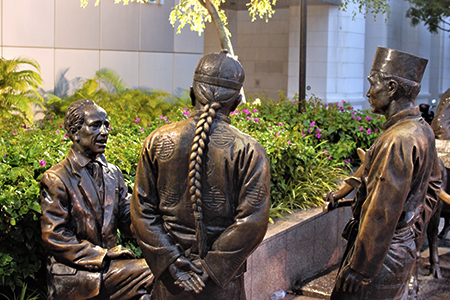Welcome to the Garden City:Singapore ! |
||
Back to The Travelarium |
||
START YOUR VISIT! |
||
|
*Onwards Singapore! The Republic of Singapore is a tiny island located one degree North of the Equator and is the world's only totally independant "island city-state". Although Singapore is a very young country, (52 years of age) , it has a fascinating history and its fast development rate allowed this little island to turn into a powerful state, playing a major role in the region. Today, Singapore is a well-planned, clean, modern and green city which has managed to retain its heritage core and grow to be an innovative and forward-looking country. Singapore's economic robustness and political stability has made the little island a destination of choice to international investors, and has earned it the title of "little red dot" of Asia. This webpage will provide you with a quick introduction to the Garden City, and perhaps help visitors understand it better! I hope you will enjoy it! |
||
|
Singapore has a recent but fascinating history in interaction with all neigbouring countries and strong British colonial roots. This page will give you the highlights of Singapore's growth and hopefully inspire you to learn more and come and visit! |
||
 |
|
Singapore has a surface area of 720 square kilometers, spanning 25km in the north-south direction, and 45km in the east-west direction. On this page, you will find a summary of the main areas of Singapore to visit if you are looking for a good feel of the city's vibes, or if you want to have a break and take refuse in one of Singapore's many parks. |
||
'City Center' Historically, the center of all activity was located in the south of Singapore, where the large ships could anchor. Today, although this is where the CBD has been constructed, many heritage quarters have been salvaged. The map below identifies a few districts which should be on any must-go list! They are: Marina Bay, China Town, Little India, Bras Basah, Kampong Glam, Katong, For more information on what to do in these areas you can visit:
|
'Singapore's Parks' Singapore is nicknamed the Garden City, and this is due to the fact that nature preservation has been a priority in Singapore's Urban planning. Singapore counts 4 nature reserves and many parks and gardens throughout the island. In the north, a fragile mangrove ecosystem is preserved and in the center of the island, the lush jungle and calm reservoirs host plenty of wildlife. In the south, the coast was re-habilitated to house pleasant parks and beaches. For more info, visit: |
|
It is very easy to commute in Singapore. The public transport system covers a large area of the island and all stations have good maps allowing quick orientation. Visitors should get an "EZ-Link" card on which money can be charged in order to enjoy the convenient & air-conditioned public transport system to the fullest. Don't forget to tap in AND out of the bus as the system makes you pay only the distance which you cover! |
||
|
||
|
Singapore 'Switzerland of Asia', Singapore 'Fine City', Singapore 'Crowded & Modern city'. That's a good start for stereotypes! But here are a few less well known fact about the city state: |
||
'Singapore Island' |
|
|
=> a tiny island famous for its tall skyscapers, however; " More than 50% of Singapore's surface is covered by nature! " |
|
|
=> a tiny island (the 19th smallest country in the world by Surface Area!) however; " Singapore's Surface has grown by 25% in 50 years, just by reclaiming land! " |
=> a young Island, Singapore is only half a century old, however; " Singapore's Airport tops world rankings with more than 55 million travellers transiting every year! Thats more than a hundred travellers every minute... " |
|
=> an island just a few meters above sealevel, however; " The Lion City is home to the world’s highest rooftop bar (1-Altitude) and the world's highest brewery (Level33)! " |
|
'Singapor...eans' |
|
Singapore is a fantastic melting pot; " 75% of Singaporeans have Chinese origins, 13 % Malay origins and 9% Indian origins. " |
|
To accomodate everyone, Singapore has four official languages: " They are: Malay, Mandarin, Tamil and English." |
|
|
Singapore has a population of 5.4 Million Residents. " With a density of 7,697 habitant per kmsq, Singapore is the 3rd most densly populated country in the world " |
Surrounded by large world powers and in a relatively young and un-stable part of the world; " All Singaporean males have to complete a 2-year long national service! " |
|
'Singapore Climate' |
|
|
Singapore is 150km north of the equator so its hot, ... very hot! " Temperature is constant, there are no seasons, and the sun sets at the same time all year round! >link< The lowest temperature ever recorded was 19.4C! " |
|
|
A Tropical climate means rain, and lots of rain! " The average humidity is 84.2%, and the average rainfall of Singapore is 2,340 mm. That's 2.5 times more than the UK! " |
A Tropical climate also means storms, hurricanes ... " Singapore does not get typhoons, hurricanes, earthquakes or tsunamis. It's biggest climate threat is the Haze, which is due to forest fires in nearby Sumatra or Borneo. " |
|






